 W
WAdele was a steel screw steamer that was built in 1906 as a yacht. She was twice commissioned into the Royal Australian Navy (RAN), firstly as HMAS Franklin and later as HMAS Adele. She was wrecked at Port Kembla, New South Wales on 7 May 1943.
 W
WThe Adelphoi was a wooden barque built in Sunderland, UK, that spent most of her working life in Australian waters. She was wrecked off Port Hacking, Australia, in 1879.
 W
WThe Adolphe was a sailing ship that was wrecked at the mouth of the Hunter River in New South Wales, Australia, in 1904. The ship is now the most prominent of several wrecks on what is now the Stockton breakwall, which protects Newcastle harbour. The rescue of the ship's crew has gone down in local maritime history as one of the most remarkable in local waters.
 W
WThe Alexander Arbuthnot is the last paddle steamer built as a working boat on the Murray River, Australia.
 W
WThe Alhambra was an iron steamer screw built in 1853 by Samuda Brothers at Cubitt Town, London. It was wrecked in a collision off Newcastle, near Nobbys Head, New South Wales, on 30 June 1888.
 W
WThe Alma Doepel is a three-masted topsail schooner and is one of the oldest such ships surviving.
 W
WThe vessel MV Blythe Star was a coastal freighter which foundered off south-western Tasmania in October 1973, leading to the largest maritime search operation conducted in Australia to that time. No sign of the vessel was ever found. The crew of ten successfully took to a small inflatable liferaft, but it was not until after 11 days and the deaths of three seamen that the survivors were found ashore in rugged terrain near Deep Glen Bay on Tasmania's south east coast. As a result of this tragedy, the AUSREP maritime position reporting system was introduced to the Australian Navigation Act.
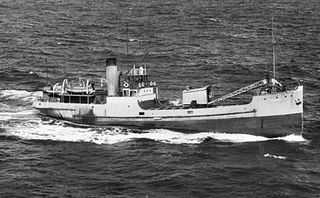 W
WThe SS Bombo was a coastal freighter which foundered on the South Coast of New South Wales, Australia in February 1949 with the loss of twelve of her fourteen crew. Built in Scotland in 1929, the SS Bombo was sailed to Australia to carry blue metal from the town of Kiama to the port of Sydney. During World War II she was requisitioned by the Royal Australian Navy and served as a minesweeper and a stores carrier in the Pacific Theatre to the north of Australia.
 W
WMSA Brolga (1102) was a minesweeper operated by the Royal Australian Navy (RAN) between 1988 and 2003. Launched in 1975 by Australian Shipbuilding Industries, the ship was designed for the Department of Transport as the lighthouse tender Lumen. Originally operating as a supply vessel for lighthouses around northern Queensland and the Torres Strait, the transition in lighthouse lights from acetylene gas to solar power meant there was less demand for the vessel, and by 1988, the Department of Transport was looking to sell the ship.
 W
WHMAS Bungaree was an auxiliary minelayer of Royal Australian Navy (RAN), serving during World War II. The ship was built as a cargo vessel for the Adelaide Steamship Company by Caledon Shipbuilding & Engineering Company at Dundee, and launched in 1937. The ship operated in Australian waters and was requisitioned by the RAN in October 1940. Decommissioned on 7 August 1946 and returned to her owners on 5 November 1947, she was sold in 1957 and renamed Dampier. She was then sold in 1960 and renamed Eastern Mariner and while operating in South Vietnamese waters she struck a mine on the Saigon River and was sunk on 26 May 1966. She was salvaged by a Japanese company and subsequently scrapped in 1968.
 W
WCato was launched at Stockton in 1800 and registered in London to Reeve & Green. She was wrecked on the Great Barrier Reef, Australia, in 1803 at.
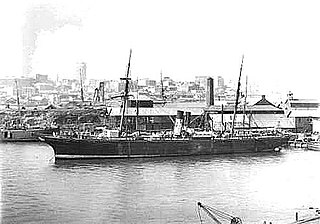 W
WThe City of Adelaide was a passenger steam ship launched during 1863 from Glasgow, Scotland. The vessel was later converted to a barque for use as a cargo transport. In 1912 the vessel was gutted by fire, and in 1916 the burnt hulk was run aground in Cockle Bay, Magnetic Island, Australia. During the Second World War four people were killed in a training accident when a RAAF aircraft struck the masts of the vessel.
 W
WCity of Adelaide is a clipper ship, built in Sunderland, England, and launched on 7 May 1864. It was built by William Pile, Hay and Co. for transporting passengers and goods between Britain and Australia. Between 1864 and 1887, the ship made 23 annual return voyages from London and Plymouth to Adelaide, South Australia and played an important part in the immigration of Australia. On the return voyages she carried passengers, wool, and copper from Adelaide and Port Augusta to London. From 1869 to 1885 she was part of Harrold Brothers' "Adelaide Line" of clippers.
 W
WColonist was a general cargo and passenger schooner built in 1861 at Dumbarton Scotland by Denny & Rankine. It spent nearly 30 years plying the Western Pacific-based out of Sydney. It wrecked and later re-floated on the remote Elizabeth Reef 550 km from New South Wales, as well as being involved in the gold rushes. Its master was murdered before it was finally involved in a collision in Sydney Harbour, in which it was sunk.
 W
WSS Colonist was a British iron-hulled coastal cargo ship driven by a 3-cylinder triple expansion steam engine. She was built in 1889 by Osbourne, Graham & Co. Ltd, North Hylton, England. She had a complement of 29 crewmembers.
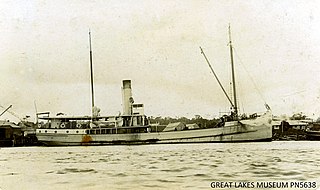 W
WThe Comboyne was a wooden screw steamer built in 1911 at Tuncurry, that was wrecked when it struck an object whilst carrying timber to Wollongong and was lost at approximately 1 mile (1.6 km) off Bass Point, Shellharbour, New South Wales on 27 November 1920.
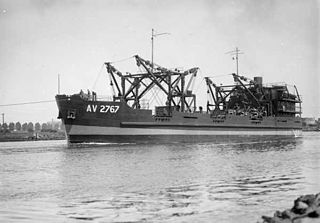 W
WCrusader (AV2767) was an Australian Army amphibious operations support ship of World War II. She was launched shortly before the war ended and entered service in late 1945. From 1945 to 1947 she was mainly used to return Australian Army equipment from the islands off New Guinea. She was also loaned to the Australian Shipping Board in early 1947 and transported earth moving equipment and timber between Melbourne and Tasmania. However, the Army did not need a ship with Crusader's capabilities after the war, and she was sold in 1947 to the Queensland Cement and Lime Company which operated her as a coral barge on the Brisbane River until the mid-1980s. The ship was scuttled in 1986 and became a popular dive wreck.
 W
WThe Dunbar was a full-rigged ship that was wrecked near the entrance to Sydney Harbour, Australia in 1857 with the loss of 121 lives. Now a heritage site, the Dunbar is a former maritime trade, troop ship and transport and now Gillies artefact collection, tourist attraction, anchor memorial, shipwreck and education facility located at Watsons Bay in the Municipality of Woollahra local government area of New South Wales, Australia. The ship was designed and built from 1852 to 1853 by James Laing & Sons of Sunderland, England. The site is also known as Dunbar Group. The property is owned by the Land and Property Management Authority, an agency of the Government of New South Wales and Woollahra Municipal Council. The site was added to the New South Wales State Heritage Register on 17 October 2003.
 W
WThe Steam Yacht Ena is a steam yacht that was built in 1900 for Thomas Dibbs, the commodore of the Royal Sydney Yacht Squadron. It was used as his private vessel for entertaining guests on Sydney Harbour and Pittwater until the beginning of World War I. In 1917 the yacht was purchased by the Royal Australian Navy (RAN) and used as the auxiliary patrol vessel HMAS Sleuth in the waters around the Torres Strait and Thursday Island, before later being used as a training ship tender based in Sydney.
 W
WFort Victoria was a 7,784 GRT cruise ship which was built in 1912 as Willochra. During the First World War she was requisitioned for use as a troopship. In 1920 she was sold and renamed Fort Victoria, serving until lost in a collision in 1929.
 W
WHereward was a full-rigged iron clipper built in Glasgow in 1877. It measured 254 feet (77 m), 39 feet (12 m) wide, 23 feet (7.0 m) deep and weighed 1,513 tons. Hereward was a British trading vessel that travelled between Britain and her colonies, especially between Sydney and London. It was shipwrecked on Maroubra Beach, Sydney on Thursday 5 May 1898.
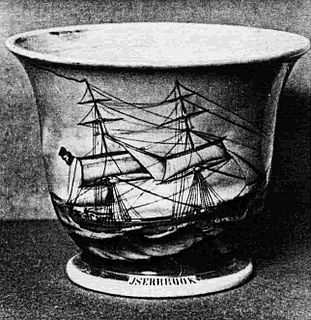 W
WIserbrook was a general cargo and passenger brig built in 1853 at Hamburg (Germany) for Joh. Ces. Godeffroy & Sohn. It spent over twenty years as an immigrant and general cargo vessel, transporting passengers from Hamburg to South Africa, Australia and Chile, as well as servicing its owner's business in the Pacific. Later on, the vessel came into Australian possession and continued sailing for the Pacific trade. In 1878 it caught fire and was sunk the same year. At last, it was re-floated and used as a transport barge and hulk in Sydney until it sank again and finally was blown up.
 W
WKowloon No.1 was a 2,942 GRT cargo ship that was built in 1943 as Empire Dirk by Ailsa Shipbuilding Co Ltd, Troon, Ayrshire, United Kingdom for the Ministry of War Transport (MoWT). Spending the war years in home waters, she was sold into merchant service in 1951 and renamed Nancy Moller, and then Mount Austin after a further sale later that year. In 1956, she was sold to the Australian Government and renamed Coolabah.
 W
WLoch Sloy was a Scottish sailing barque that operated between Great Britain and Australia from the late 19th century until 1899. Her name was drawn from Loch Sloy, a freshwater loch which lies to the north of the Burgh of Helensburgh, in the region of Argyll and Bute, Scotland. Ships Captains: 1877 - 1885 James Horne, 1885 – 1890 John McLean, 1890 – 1895 Charles Lehman, 1895 – 1896 James R. George, 1896 – 1899 William J. Wade, 1899 Peter Nicol.
 W
WLoch Vennachar was a three-masted iron sailing ship (clipper) that operated between Great Britain and Australia between the late 19th century and 1905. The name was drawn from Loch Venachar, a lake which lies to the south-west of the burgh of Callander, in the Stirling region of Scotland. It is understood to mean "most beautiful lady" in Scottish Gaelic.
 W
WMV Macdhui was a steel hull passenger and cargo motor vessel built by Barclay Curle & Company at the Clydeholm Yard, Whiteinch, Scotland for Burns, Philp & Company, Limited, Sydney NSW, Australia. The ship was launched on 23 December 1930 and completed during March 1931. The ship operated with the company's Burns, Philp Line with service to Papua and New Guinea. She was sunk in 1942, as a result of damage suffered by being hit by bombs from Japanese aircraft, near Port Moresby.
 W
WTSS Maianbar was a coastal steamship of the North Coast Steam Navigation Company. She was built in Scotland in 1910 and ran aground in Newcastle, New South Wales in 1940.
 W
WSS Makambo was a steamship first owned by Burns Philp & Co. Ltd. She was built in Port Glasgow in Scotland and named after an island in the Solomon Islands. She carried both passengers and cargo and was principally used on routes between eastern Australia and islands in Melanesia and the Tasman Sea. In November 1908 Jack and Charmian London travelled from Guadalcanal to Sydney on the Makambo after abandoning their ill-fated circumnavigation on the Snark, a 45' sailing yawl.
 W
WHMAS Mallina was a 3,213 GRT cargo ship built by Harland & Wolff, Belfast in 1909 as Mallina for the Australian United Steam Navigation Company for the Rockhampton to Sydney cargo route. She was requisitioned by the Royal Australian Navy in 1914, as a store carrier and collier. She was returned to her owners in 1915. She was sold in 1935 to Machida Shokai Kisen Kaisha, Japan and renamed Seiko Maru, before being sold to Kita Nippon Kisen Kaisha and renamed Siberia Maru No. 3, which was later shortened to Siberian Maru. While steaming in the Sulu Sea, Philippines on 24 September 1944, she was attacked by American aircraft of Task Force 38 and sunk with the loss of 158 of the 2,382 people on board.
 W
WThe motor vessel MV Mamutu, an Australian merchant ship built in Hong Kong in 1938, was of 300 tons gross, 113 feet (34.4 m) in length, and had a beam of 25 feet (7.6 m). She operated on an inter-island trade route for Burns Philp & Company, and at the outbreak of World War II, she was engaged in the evacuation of civilians ahead of advancing Japanese forces in New Guinea. She was sunk in August 1942 by the Japanese submarine Ro-33 in the Gulf of Papua near Murray Island.
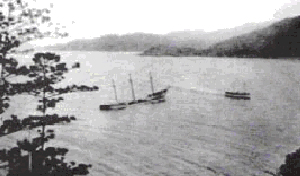 W
WThe Moltke was a three-masted barque built in Hamburg, Germany in 1870. The vessel was wrecked off the coast of northern Queensland, Australia in 1890 before being refloated and hulked. In 1911 the vessel was scuttled off Geoffrey Bay, Magnetic Island. The wreck of the vessel now hosts a wide range of underwater life and is a popular open-water dive site.
 W
WParramatta was a sailing ship launched at Sunderland in 1866 that operated between Great Britain and Australia and America from 1866 to 1898. She was the second fastest Blackwall frigate. She originally carried wool from Australia to the United Kingdom. She foundered in 1898.
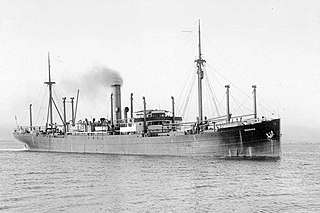 W
WPfalz was a 6,557-ton cargo steamer operated by German shipping company Norddeutscher Lloyd. The ship became the target of the first shot fired by Australian forces in World War I, soon after departing the Port of Melbourne in Australia.
 W
WQueen Of Nations was an 827-ton wooden clipper ship. She was built in Aberdeen in 1861, and sailed out of Auckland, New Zealand, on the Sydney to Liverpool route. The ship was admired for its speed and sleek lines.
 W
WMV Reef Endeavour was built at the Fiji Government dockyard, Suva Fiji and was the first ship to contact the Great Barrier Reef as an attraction, in 1996, an important milestone for tourism in Australia. Initially built for a joint venture between Captain Cook Cruises and Qantas, she was later purchased from the joint venture by Captain Cook Cruises and transferred to Fiji. She is today one of many ships that operate around the Fiji Islands exploring the Mamanuca and Yasawa Islands every week and Vanua Levu once a month. What makes the Reef Endeavour exceptional, is her small size allows her to reach remote reefs, islands and shallow bays, where bigger ships cannot proceed. Her design allows for big ship qualities, whilst maintaining a small ship feel. These features include a pool, spa, and an embarkation platform allowing access and storage for smaller boats.
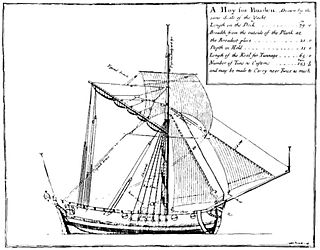 W
WRose Hill Packet, was a marine craft built in Australia, named after the second place of European settlement in Australia, "Rose Hill", the furthest navigable point inland on the Parramatta River. The boat design was later called a packet boat, because its use was that of running the first Parramatta River trade ferry, passenger, cargo, and mail service between the Sydney Cove and the Rose Hill (Parramatta) First Fleet settlements after she was launched in Sydney Cove in September and commissioned on 5 October 1789. She was the first purpose-built sailing vessel constructed in Australia.
 W
WSuccess was an Australian prison ship, built in 1840 at Natmoo, Burma, for Cockerell & Co. of Calcutta. Between the 1890s and the 1930s, she was converted into a floating museum displaying relics of the convict era and purporting to represent the horrors of penal transportation in Great Britain and the United States of America. After extensive world tours she was destroyed in 1946 by fire while berthed in Lake Erie near Cleveland, Ohio.
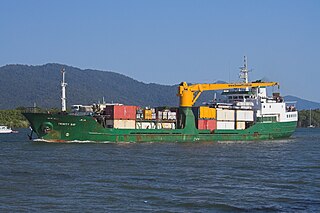 W
WMV Trinity Bay is a 1,594 gross tonnage (GT), 81 metre long, Coastal Freighter owned by the Sea Swift shipping company based in Cairns, Australia. It runs a weekly service supplying communities on the Cape York Peninsula and in Torres Strait. Formerly a Sand Dredge, the Trinity Bay was converted into the current layout during the year 2000 in Cairns Shipyards. Even though the ship is a fully commercial cargo ship, she regularly carries 40 passengers to and from Thursday Island.
 W
WThe Wanganui was an iron Brigantine Twin Boiler Screw steamer built by Gourlay Brothers & Co and launched in July 1863 for the Wanganui Steam Navigation Company for trade around the Wanganui region of New Zealand. The vessel served in this region up to 1873 when its ownership was transferred to Messrs Henry Houghton and Co., of Dunedin. In 1880 the vessel was transferred in to the Australian East coast service where it sunk whilst entering Clarence River on 20 June 1880
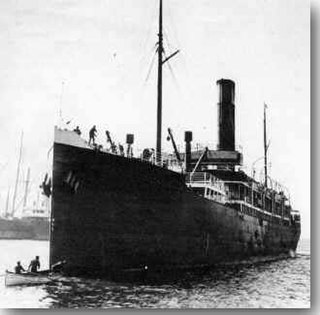 W
WThe passenger ship SS Yongala sank off Cape Bowling Green, Queensland, Australia on 23 March 1911. En route from Melbourne to Cairns she steamed into a cyclone and sank south of Townsville. All 122 aboard died, and traces of the ship were not found until days later, when cargo and wreckage began to wash ashore at Cape Bowling Green and at Cleveland Bay. It was believed that the hull of the ship had been ripped open by a submerged rock. The wreck, which has become a tourist attraction and dive site, was not found until 1958.